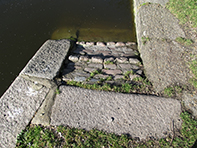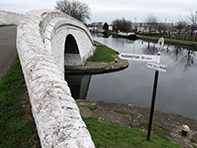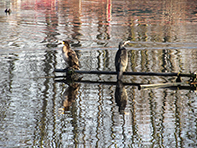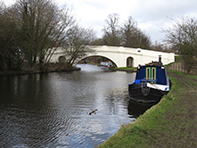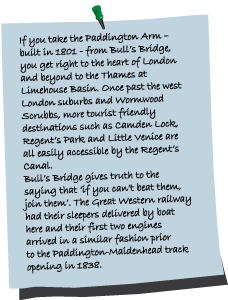
The Hillingdon Trail under the A312 isn't exactly an enticing proposition and you go over the River Crane without really noticing it. Walkers then used to be envigorated by the smell of coffee that permeated the air from the nearby Nestle's factory which opened in 1914 due to the site's proximity to both canal and rail, this has now been replaced by apartments that form part of a mixed development called 'Hayes Village'.
Further on under the Elizabeth Line, the old carriage shed and adjacent land have been turned into high rise residential blocks. And more development takes place just before Anchor Bridge. Adjacent warehouses and factories are mostly hidden by trees but, before Woolpack Bridge, a trading estate comes into view where there used to be a turpentine refinery. The estate is home to the EMI Archive Trust, located at Vinyl Place, an appropriate site as it's a stone's throw away from the former EMI record pressing plant and where HMV manufactured gramophones and record players.
The canal continues in similar fashion mostly lined by trees blocking out the view of neighbouring industry. It begins to run parallel with the Elizabeth Line with just a cement works standing out like a sore thumb. Stockley Park, best known to football fans as the home of VAR, is on the towpath side but largely out of sight but you won't miss Prologis Park, a very smart business estate built on an old brick field which is in stark contrast to the worn out industrial buildings opposite. West Drayton Station is passed and you go under the striking Colham Bridge costing £200,000 and part of a plan to smarten up Yiewsley.The Slough Arm is reached at Cowley Peachey Junction with the Packet Boat Marina located on the corner. London's demand for locally produced bricks was the reason for constructing the arm in the 1880s and in return London sent Slough its rubbish. The last commercial traffic to Slough was in 1960 and the arm was subsequently nearly filled in, re-opening in 1975.
High Line Yachting, the entrance to Packet Boat Dock, the WatersEdge (sic) pub are all in close proximity near Packet Boat Bridge. Cowley South and North long term visitor moorings now mean that vessels and houseboats of all descriptions line the canal up to and past Cowley Lock (89) which ends a long lock free stretch with its attractive lock cottage and the Malt Shovel pub.
Before reaching Dolphin Bridge, which is guarded by a pill box, and the General Eliott pub (1824) you pass the Hillingdon Canal Club and Uxbridge Boat Centre which occupies the site of a Fellows, Morton & Clayton maintenance and boat building yard (1896 – 1949). Now developed into flats, Waterloo Wharf was an early coal wharf dating from 1793.
Although represented for some time by Boris Johnson, Uxbridge isn’t a bad town, at least it has some history - the first stage on the coach journey from London to Oxford and, well before that, where Charles I held crisis talks in The Crown with his parliamentary foe during the Civil War. More recently, RAF Uxbridge was the location from where the air defence of south east England was coordinated during the Battle of Britain.
From Dolphin Bridge you pass a nondescript business estate, long term and visitor moorings on the excellent tow path. There were once a collection of wharfs and arms around Uxbridge Bridge, a striking art deco building now occupies Way's Wharf and you soon get to Sand River and Denham Marina followed by Uxbridge Lock. The River Colne joins from the left forming a winding hole and then, just after it leaves again, you go under Western Avenue (A40) where graffiti sudenly kicks in, especially splattering Denham Farm Bridge. A noticeable aspect of the canal from Uxbridge is not only the diversity of boats but the number that are sunk especially leading up to Denham Deep Lock which, dropping just over 11ft, is the deepest lock on the Grand Union. Here you'll also find Fran's Tea Rooms next to the aquaduct crossing Fray's River.
The canal continues through the Denham Country Park. Adjacent are nature reserves and trails as you traverse the Colne Valley wetlands resulting from gravel extraction. Pylons pockmark the landscape and a massive HS2 viaduct glides over the water on its way to destroy the Chilterns. Passing Harefield Marina you continue to Widewater Lock, where you'll find the River Garden pub, and onto Black Jack's Mill, an old corn mill now a restaurant, and Lock 85. (The name is supposed to be derived from 'Black Jack' who was hired by a local landowner to harass boatmen.)
Expensive properties now appear on the far side as you pass two winding holes on the way to the Coy Carp public house and Copper Mill Lock 84. The name derives from the adjacent industrial site that is now residential and also the home to the Hillingdon Narrowboat Association. The mill took copper from Wales and turned it into sheathing for the Royal Navy. When wooden hulled boats went out of fashion the business became uneconomic and the buildings were subsequently used to produce asbestos and then rubber goods. A little further on is the re-developed site of the Harefield Lime Works
During cold weather you may notice steam rising from the water hereabouts and, as you continue towards Springwell Lock 83 a very large pipe crosses the canal and the air becomes slightly malodourous. This is due to the nearby presence of the giant Maple Lodge sewage works which was one of the last places to receive coal via the canal. Next up is the Springwell Reedbed, the largest of its kind in London and home to all sorts of birds and other wildlife, watch out for bats at dusk and murmurations of starlings in the autumn. On the opposite bank there is a line of derelict and well used working boats leading to the yard of Wood, Hall & Heward who are specialists in floating plant hire and water transport.
After Springwell Lock there’s long term moorings with sets of tables and chairs before you leave the London Borough of Hillingdon and start to enjoy the Hertfordshire countryside - the land of chalk streams, old gravel pits converted to nature reserves, watercress beds and paper making - where the canal has a symbiotic relationship with three rivers, the Chess, Colne and Gade.
Chalk and lime pits were present in the area as early as the 1300s. This industry continued together with the extraction of sand and gravel into the twentieth century, no doubt stimulated by the presence of the canal. It's worth noting that huge amounts of aggregate from the pits was used in the building of the first Wembley Stadium and that the quality of the water was so good that there was a Springwell Mineral Water Works and watercress was grown nearby until the 1980s.
At Stocker's Lock, coal boats were gauged for payment of coal tax to the City of London and it gives its name to the adjacent nature reserve which attracts important numbers of wintering birds such as goldeneye and smew. A little further you will not fail to see the derelict limestone processing plant well known locally for the stuffed monkey that hangs from its rafters.
You then reach Rickmansworth, 'Ricky' to the locals, where another Tesco has been built on the site of Frogmoor Wharf and Walker’s boatyard. At Batchford Lock, Salter’s Cut aka the Gasworks Arm off to the left once served Samuel Salter’s brewery. Bridge 172 allows you to continue along the canal away from the visitor centre, going by a café before passing a line of boats and onto Lot Mead. The Metropolitan Line crosses the canal on its way to Croxley before you reach Common Moor Lock. Croxley is of course a famous make of paper and John Dickinson chose Common Moor to build a paper mill in 1829. it ceased production in 1980. Housing and business units are now on the mill site and Common Moor is a SSI.
From here the canal goes under road and rail bridges including one huge structure near Bridgewater Boats taking the Met to Watford. You walk past a large variety of boats including impressive wide beams and permanent structures built on the water. Soon there’s Cassiobridge Lock and then, adjacent to sports pitches, Iron Bridge Lock which JMW Turner used as a viewpoint for several sketches of Cassiobury Park just after it was redsigned for the 5th Earl of Essex at the turn ot the 19th century. Watercress beds used to proliferate in the clean waters of the River Gade which runs parallel to the canal and the park is now the largest green space in Watford, the towpath is very popular with cyclists and walkers.
Crossing to the other side over bridge 166, the surroundings on this stretch are particularly attractive before turning sharply to pass Grove Mill and then again to reach a striking white decorative bridge leading to The Grove golf course, one of the country’s finest apparently. The bridge looks good at any rate. The canal was originally planned to take a different route with locks from Ricky, through a tunnel west of Hunton Bridge and then an aqueduct at King's Langley onto Boxmoor. However it was re-routed following the Gade Valley and the ornamental bridge was part of the deal with the landowner Lord Clarendon
Cross bridge 163 to the other side near Lady Capel’s Wharf which was the main commercial wharf serving Watford. Boats were gauged for the payment of coal tax here before the task moved to Stocker's Lock. To avoid the tax, coal would be unloaded and carried by cart to London. You arrive at her ladyship's eponymous lock before going under a busy M25 feeder road. Not far is Hunton Bridge Locks and it all gets a bit loud as the canal nestles between the A41 and the West Coast main line. But it's not unattractive and refreshment is within easy reach of bridge 162 if you need a break.
View Bull's Bridge to Watford in a larger map

